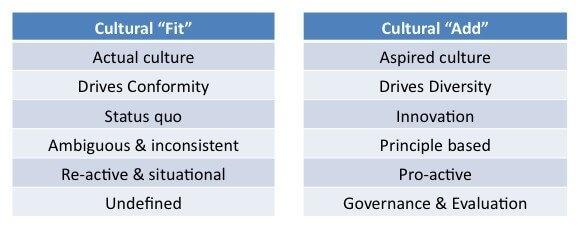
How To Build An Inclusive & Diverse Culture in The Workplace
The "Me Too Movement", "Black Lives Matter", "Harvey Weinstein Scandal" and other major events have pushed the pitfalls of organisational culture into the limelight.
Company culture is a key factor in the talent selection process and plays an important part in the success and growth of major firms; but is 'culture fit' really the right answer to diversity and inclusion in the workplace?
Diversity as a Competitive Driver
According to McKinsey and Company, the organisations that are more gender diverse are 15% more likely to outperform others; those which are ethnically diverse are 35% more likely to outperform others.
Today’s digitalisation connects the world, companies and workforces, resulting in an increasingly competitive business landscape which demands continuous innovation in order to stay ahead. One would expect companies to actively seek out a diverse workforce in their efforts to establish a culture of innovation and competitive effectiveness.
The Changing Cultural Landscape
The majority of companies have a global footprint that is larger than their origin operations, far removed from HQ. Such a global workforce may not mean a diversity of thinking or local adherence to with the ‘company culture framework’.
Companies like Salesforce and MasterCard take a proactive and public approach to driving a diversity agenda. Their efforts through workforce councils, resource groups and communities, (which SalesForce calls its “Ohanas”), or families proactively drive the governance of company culture.
Hiring and retention in such a context can then move away from ‘fit’ to the actual culture with an ‘addition’ to the aspired culture in order to celebrate diversity and more importantly add to the company’s reputation and attractiveness.
Reconsidering Cultural ‘Fit’ in the Hiring Process
There is a direct relationship between the hiring pool and the actual hiring decision. Simply put: to increase the diversity of your workforce you will need to have sufficient minorities as part of your interview pool.
Cultural fit implies a perfect company culture to which new hires are expected to blend in and adopt. It suggests a ‘correct’ status quo where diversity and competitiveness are boxed in and optimal company culture and competitive performance are blocked. There is a major risk that fit and bias will take over at the cost of diversity and cultural breadth.
Cultural add is a relatively new concept that has gained momentum in the last few months. It emphasises how fresh and unique, not boxed ideas, allows individuals to contribute more to company culture and values. It is not limited to new hires; the concept likewise implies that leadership in embracing this new concept and embedding it are critical.
The Benefits of ‘Cultural Add’ over ‘Fit’
Company culture can be described as a number of factors such as vision, values, norms, systems, symbols, assumptions, beliefs, and habits. An evaluation of these factors helps to drive a concise and cohesive company culture, and move away from any bias and ambiguity especially concerning ‘unwritten rules’.
The principle of ‘fit’ is often undefined and based on gut feeling, and is even as simple as whether people like to go for a beer after work or go for karaoke depending in what part of the world you find yourself.
The differentiation and the benefits of a cultural ‘add’ versus a ‘fit’ can are becoming very obvious now and are shown in the below model.
Model 1 – differences of a company’s ‘cultural add’ and ‘fit’ to underpin diversity
The way people can contribute to add to the company culture and objectives can be more easily identified and valued if the culture is clearly defined and driven by concrete examples and specific principles.
Companies like Salesforce publish their diversity metrics annually, as well as their approach and governance to their cultural framework and diversity, allowing people to understand and achieve the aspired culture.
How to Create a Diverse & Inclusive Workplace Culture
Hiring for ‘cultural add’ can only be effective when the cultural framework and its aspirations are embedded throughout the company's communities, partners and customers.
A proactive approach to company culture with a focus on ‘cultural add’ will make companies more innovative and employers more attractive to a diverse talent pool in return.
Here is how business leaders can create a diverse and inclusive workplace:
1. Establish a sense of belonging and togetherness for everyone
2. Listen to your employees and encourage change
3. Hire, retain and nurture talent regardless of their background, religious views, colour of skin, sexual orientation and physical appearance
4. Provide continuous feedback and minimise fear
5. Develop more inclusive processes and organise more workshops
6. Promote inclusion and diversity across all leadership levels
Trending
-
1 SEO Mistakes That Could Be Costing Your Shopify Store Sales
Daniel Hall -
2 Strategies for Safeguarding Assets and Investments
Daniel Hall -
3 The Role of PR Firms in Crisis Management and Damage Control
Nitish Mathur -
4 How to Make Appealing Visuals for Your E-commerce Store
Daniel Hall -
5 The Competitive Landscape of Low-Cost Carriers in Belgium: TUI Fly Belgium’s Position
Daniel Hall






Comments